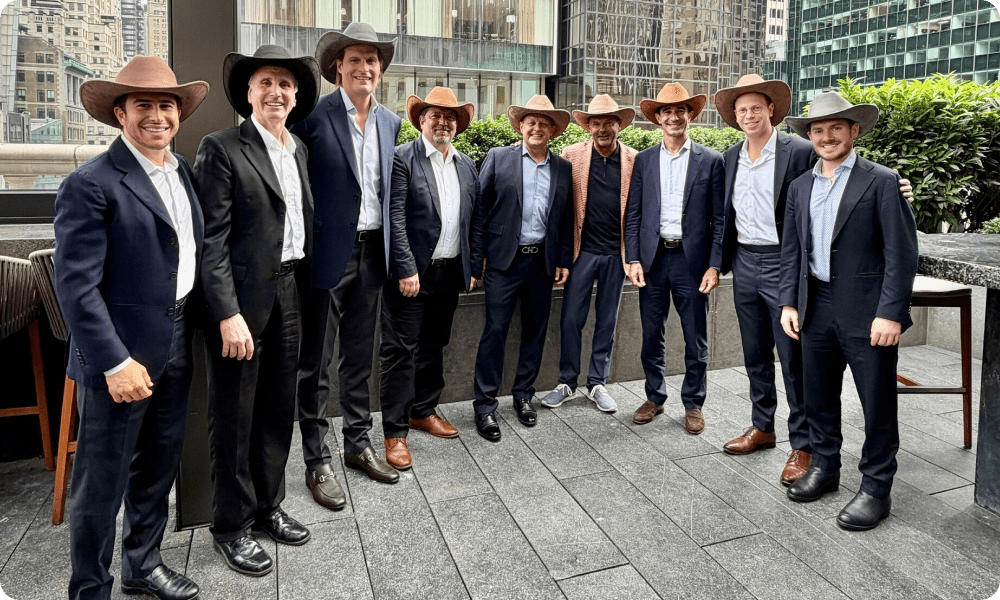Marketplace Regolith
Your investment opportunities
Fermi
U.S. data center REIT
Updated on 15 Dec 2025

Toby Neugebauer
CEO
“Fermi transforms clean energy into computing power — and that power into new opportunities for innovation.”

Updated on 15 Dec 2025
Why Fermi Is a Must-Have in Your Portfolio
Fermi is a next-generation data center developer based in Texas, building what is set to become the world’s largest campus with up to 11 GW of capacity. The company holds a 5,236-acre site under a 99-year lease and plans to generate its own power through gas, solar, batteries, and nuclear energy. This approach enables control over the critical resource of energy supply and supports a resilient infrastructure for AI and cloud computing.
The company plans to offer 25 million shares + 3.75 million underwriters’ option at a valuation of around $12–13 billion, making the IPO of Fermi one of the largest events of 2025 in the data center infrastructure sector.
Ecosystem and business model — Fermi is structured as a REIT and intends to distribute dividends once the project becomes profitable. While still in the construction and capital-raising stage, the project’s scale and access to its own energy resources create long-term advantages over traditional players.
The growing demand for computing power and the rapid development of AI provide favorable conditions for market expansion. Fermi holds a unique position in this niche and represents an attractive investment opportunity amid the global trend toward digital infrastructure.
Exclusive Participation Terms
The IPO of Fermi is considered one of the most notable listings of the fall in the digital infrastructure sector, driven by its REIT structure and dividend-oriented model for investors.
The company is going public on Nasdaq and LSE with an offering of 25 million shares + 3.75 million underwriters’ option at a valuation of around $12–13 billion, making the IPO of Fermi a key event of 2025 in the data center and energy real estate segment.
Application and funding deadline — Tuesday, September 30, 18:00 (Dubai time).
Key Facts Investors Should Know
• Project scale: construction of the world’s largest data center campus with up to 11 GW of capacity in Texas.
• Own generation: gas, solar, battery storage, and nuclear power for reliable energy supply.
• Unique resource: 5,236-acre land plot under a 99-year lease.
• Investment format: REIT status with plans to pay dividends once profitable.
• Market driver: rapid growth in demand for computing power and AI infrastructure.
The Founding and Growth of Fermi
Fermi was established in Texas as a next-generation data center developer and from the outset announced its ambition to build the world’s largest campus with up to 11 GW of capacity. At launch, the digital infrastructure market was facing a shortage of capacity and a reliance on unstable power supply. Fermi offered a comprehensive solution: data centers with their own generation based on gas, solar, battery storage, and nuclear energy — allowing control over the key resource of power and reducing operational risks.
The company stands out by scale: a 5,236-acre land plot is secured under a 99-year lease, providing a foundation for long-term development. With its REIT status, Fermi is set to adopt a dividend-paying model once the project turns profitable. Despite no current revenue, the project already attracts significant investment thanks to its unique combination of scale, technology, and focus on the fast-growing demand in AI and cloud services.


The name Fermi is symbolic: it references Enrico Fermi, one of the pioneers of nuclear energy, and reflects the company’s ambition to merge energy and computing at a scale that will define the future of the digital economy.
Fermi’s revenue model will be driven by leasing data center capacity along with its REIT structure, which provides for regular distributions to investors. The combination of in-house energy generation and scalable infrastructure creates long-term competitive advantages over traditional players.
The IPO of Fermi, valued at around $12–13 billion with an offering of 25 million shares + 3.75 million underwriters’ option, is set to become one of the key events of fall 2025 in the digital infrastructure sector. For investors, this is an opportunity to participate in a project at the intersection of real estate, energy, and technology — a market whose importance is rapidly growing amid global demand for computing power.
Frequently Asked Questions (FAQ)
— What is an IPO?
An IPO (Initial Public Offering) is when a private company lists its shares on a stock exchange for the first time to raise capital from investors. From that point onward, the company’s shares can be freely bought and sold on the open market.
— Where are IPOs conducted?
IPOs take place on the world’s largest stock exchanges. In the U.S., the primary venues are the NYSE (New York Stock Exchange) and NASDAQ. Once a company goes public, its shares are freely traded on these exchanges, and the market price is established after the offering.
— What is allocation?
Allocation (from “allocation” — distribution) refers to the process of distributing resources, assets, or capital for maximum efficiency. In investing, allocation usually means distributing the available amount of shares among investors in an IPO or private placement.
— How much allocation does an investor receive?
The allocation size depends on the specific deal and typically ranges from 2% to 30% of the submitted order. In rare cases, allocation may reach up to 100%. Information about the actual IPO volume and share price we entered at becomes available roughly one day before the offering, approximately six hours prior to the trade.
Example — Bullish IPO (Aug 13, 2025):
An investor placed an order for $10,000. The allocation was 29.6%, meaning $2,960 was invested in the IPO. The remaining $7,040, including the purchase commission, was refunded to the balance and became available for withdrawal.Klarna IPO (Sept 10, 2025):
An investor placed an order for $10,000. The allocation was 14%, meaning $1,400 was invested in the IPO. The remaining $8,600, including the purchase commission, was refunded to the balance and became available for withdrawal.Figure IPO (Sept 11, 2025):
An investor placed an order for $10,000. The allocation was 16%, meaning $1,600 was invested in the IPO. The remaining $8,400, including the purchase commission, was refunded to the balance and became available for withdrawal.Gemini IPO (Sept 12, 2025):
An investor placed an order for $10,000. The allocation was 29%, meaning $2,900 was invested in the IPO. The remaining $7,100, including the purchase commission, was refunded to the balance and became available for withdrawal.Legence IPO (Sept 12, 2025):
An investor placed an order for $10,000. The allocation was 78%, meaning $7,800 was invested in the IPO. The remaining $2,200, including the purchase commission, was refunded to the balance and became available for withdrawal.Black Rock Coffee Bar IPO (Sept 12, 2025):
An investor placed an order for $10,000. The allocation was 68%, meaning $6,800 was invested in the IPO. The remaining $3,200, including the purchase commission, was refunded to the balance and became available for withdrawal.
— Why do companies go public?
To raise growth capital, increase brand visibility, and provide early investors and employees with an opportunity to sell part of their shares.
— How is participating in an IPO different from buying shares on the exchange?
When you participate in an IPO, you buy shares before they start trading publicly. This provides an opportunity to purchase at the fixed offering price but also carries the risk that the price may drop once trading begins.
— What do I get by participating in an IPO through Regolith?
You become an investor in the company at the IPO stage via our U.S. partner infrastructure. After the transaction is completed and the lock-up period expires, profits from the share sale are distributed among investors proportionally to their stake in the deal.
— What is a lock-up period and how long does it last?
A lock-up period is a timeframe set by the issuer and underwriters during which shares cannot be sold. For IPOs offered through our platform, this period is 93 days. Once it ends, the shares are sold on the exchange and proceeds are distributed among investors.
— How is participating through the platform different from buying shares independently?
To buy independently, you would need access to a U.S. broker, a significant investment amount, and approval from underwriters. The platform pools capital from investors, providing access to IPOs that are otherwise unavailable to most individuals.
— Through whom is IPO participation carried out?
We operate through a U.S.-based structure that works with a licensed broker in the U.S. Our partner selects promising IPOs and participates in the offering under its own name.
— How is the deal structured legally?
An investor signs an agreement/offer to participate in the investment product. Regolith then transfers funds to its partner entity — Wealthy Labs Limited (the provider), which enters into a forward contract with the broker and executes all operational activities. The provider delivers the financial outcome to Regolith, which then distributes proceeds among investors.
— Is there a minimum investment amount?
Yes. Each IPO has a defined minimum entry threshold, shown on the offering page. On average, Regolith provides access starting from $500.
— Do I receive shares into my personal brokerage account?
No. Shares are purchased and held in the partner’s brokerage account. After the lock-up period, the broker sells the shares and transfers proceeds for distribution among investors.
— Can shares be transferred directly to my brokerage account?
No. Participation is structured via a forward contract with the partner’s brokerage infrastructure. The deal is executed on behalf of the partner, and settlements with investors are carried out through the platform.
— How can I sell my shares after the IPO?
Sales are processed automatically: once the lock-up expires, the partner broker sells the shares on the exchange, and proceeds are distributed proportionally among investors.
— What are the risks of investing in IPOs?
IPOs are high-risk investments. While they may offer high returns, they also carry significant volatility. Share prices on the first trading day — and after the lock-up — can fluctuate sharply. There is a risk that the market price will fall below the offering price. In addition, macroeconomic and sector-specific factors can affect outcomes.
— Can I know in advance how much I will earn?
IPO returns are not guaranteed. The final result depends on the share price at the time of sale after the lock-up, overall market conditions, and the company’s performance.
— How can I verify that Regolith participates in IPOs?
We publish all available deal information in the client dashboard. Additionally, we provide an agreement disclosing the infrastructure used for transactions. Broker and partner documents are not shared, as they contain confidential data protected by contractual obligations.

Toby Neugebauer
CEO
“Fermi transforms clean energy into computing power — and that power into new opportunities for innovation.”
Details
Ticker
FRMIExchange
Nasdaq + LSEIPO Price Range
$18–22IPO Valuation
~$12–13BShares Offered
25M + option 3.75MUnderwriters
UBS, Evercore, Cantor, Mizuho.IPO Date
1 Oct 2025Submit by
30 Sep 2025, 6:00 PM (UAE)Terms
Deal Fee
5%Carried Interest
30%Risk potentinal
Very HighLock-up period
93 daysFermi
U.S. data center REIT
Updated on 15 Dec 2025

Toby Neugebauer
CEO
“Fermi transforms clean energy into computing power — and that power into new opportunities for innovation.”

 Русский
Русский 















